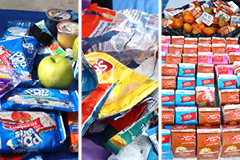
Material categories in sorts highlight unopened, packaged food that could have been recovered. Photos courtesy of SCDHEC
South Carolina has about 1,250 public schools with more than 775,000 students and 54,000-plus teachers and staff. To get a more concrete idea about solid waste composition at the schools, the S.C. Department of Health and Environmental Control (DHEC) characterized the solid waste generated throughout one day at 6 public schools in the state. The analysis includes the amount of waste (by weight), type of waste, how the waste was managed (sent to the landfill, recycled, donated or composted) and the level of contamination (items that can’t be recycled) in school recycling containers.
“School waste is generally similar from school to school — particularly within the same grade tier,” notes the study, “No Time to Waste: An Analysis of the Material Generated, Discarded and Recovered at South Carolina’s Public Schools”. “Given that, the summaries of waste generated by the schools in this study should be typical of waste generated at all of South Carolina’s public schools.” Included were 2 high schools, 2 middle schools, 1 elementary school and 1 charter school, ranging in size from 531 to 1,805 students. Each of the schools had a recycling program.
Key takeaways from the food waste study include:
• Student per capita waste generation ranged from a half pound to one pound. Thus at a minimum, schools generate 375,000 pounds of waste every school day. Recommendations to address this include improving signage to reduce contamination in current recycling programs and establishing a reuse area for supplies.
• 5 of the 6 schools in the study could have diverted more than half of the waste sent to the landfill through prevention, recycling, donation or composting. Four could have diverted more than 60 percent. Recommendations for this issue include upgrading current recycling programs and expanding into using commercial composting programs.
• Unwanted food accounted for 32% to 55% of the waste the 6 schools generated. Recommendations include implementing Smarter Lunchrooms Movement strategies, share tables, and offer vs. serve, which allows students to decline some food items and select others they intend to eat.
Two of the six schools in this study had share tables plus one school was piloting a program — all were successful. Conversely, about 35% of the food sent to the landfill from one school was unwanted fruit and unopened milk and juice containers that could have been easily rescued. It is estimated that by using a share table or donating this school could have diverted 5 tons of material from the landfill.










